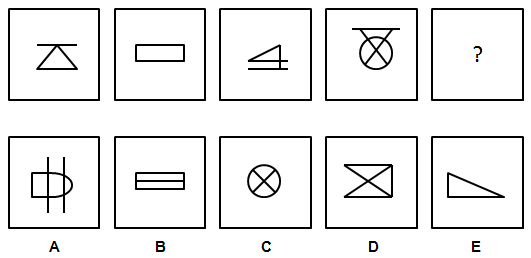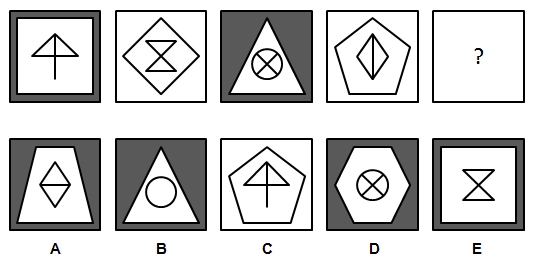Basic Inductive Reasoning Questions
Occupational assessments play significant part of recruitment process in large multinational companies and are often administered at the early stages of employee selection. Often such exercises comprise wide range of items series and evaluate the extent to which potential recruits can think logically and analytically. A good example of such exercises are logical reasoning ability tests that are frequently administered to high calibre candidates to see how they can manage challenging or problematic situations. The below section is designed to help you understand underlying mechanics of problems incorporated into these assessments composed of non-verbal items or abstract series.
To test your ability to work out related problems try to answer the below question in less than 30 seconds. Notice, your task is to compare the images and identify underlying rationale that links them in the sequence. Then pick tile from five choices provided which would complement the row. You may start now.
 |
Any luck on the above? Even though the problem seems to be difficult to work out the logic behind it is straightforward and simple. A number of students would spend long time searching for certain order in which the shapes are arranged only to find out that it makes no sense. Note, all what is required is to count the number of lines in each tile. That is the item in the first tile consists of four lines, the second shape is created from four lines etc… so the fifth object must be made up of four lines as well. Therefore, the next box in the series must be A as it is the only option with four strings. Thus, when completing logical or abstract reasoning aptitude tests you need to think of every possible way to tackle the test question.
 |
Similar but slightly different example is displayed in the above sample question. Again, many may search for characteristics that are irrelevant such as angle types, orientation or line movements. The order of the shapes in the sequence is set to make the question to look a bit more difficult to assess your ability and competence to think on your feet. Note that when if you pay attention and closely examine the series you would find that in each tile the number of lines of inner and outer shapes are always equal. For instance, in the first square both objects have four lines and so in the second. The third box presents with symbols that have three lines etc... When you inspect carefully five answer choices offered E must be the correct answer as the number of lines of inner symbol corresponds to the number of lines of the outer object. It’s that simple.
In your logical reasoning test you must attempt to detect analogies, relationship or links between images swiftly and consistently. To help you with this you can go through our tutorial on most common logical patterns to learn about the common trick of logic series that may consist of different shape sizes, shading, orientations or reflections. It will provide you with tips and expert advice how to find links between items quickly. Remember, a good tactics is to identify similarities or differences between items then find the common connectors and finally apply the rule or principles found.

